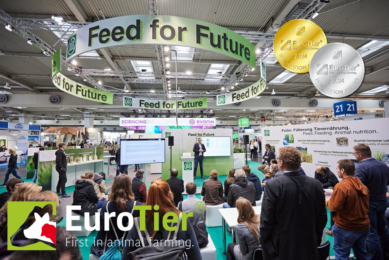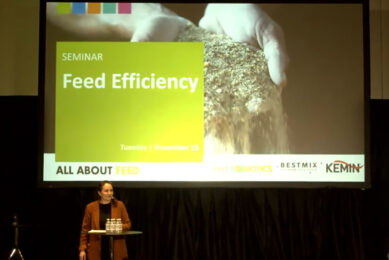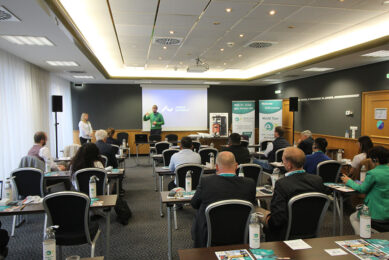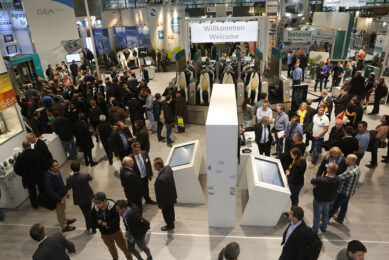Feed’s new life in the limelight at EuroTier
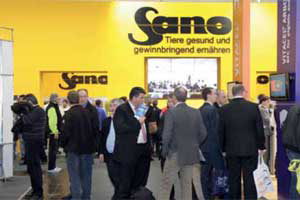
The role of rations in animal welfare, disease resistance, fertility and in enabling levels of performance never dreamed of before is probably only just beginning to be really understood. The organiser of EuroTier thinks it’s high time that farmers and other visitors to the world-class exhibition had the opportunity to learn more about the new future for animal feed and have opened a special information gallery to help.
Feed is a focal point of this year’s EuroTier exhibition, proclaimed the biggest show of its kind in the world by organisers, the German Agricultural Society (DLG). The show itself features a record number of exhibitors (2,370 from 51 countries) with the highest number of exhibition halls (16 over 24 hectares) ever, and visitor numbers expected to exceed the best-ever 140,000 of the last EuroTier event.
And this is also to be an exhibition where society concerns will be given more attention than ever before. For instance, concerns about feed, its ingredients and the effects of highperformance rations on the environment, the carbon footprint of farming, finite resource depletion, animal welfare, health and, ultimately, the health of consumers themselves. Feed costs are also rising non-stop during 2012. So there’s a lot of soul searching in the feed sector about keeping inclusion rates of the most expensive ingredients down – and maybe replacing soybeans, for instance. But with what? The resultant industry worries will be very evident at EuroTier. For instance the innovations competition for the famous DLG medals feature a battalion of feed and ingredient producers with new products and ideas for performanceincreasing, cost-reducing, antibioticavoiding rations.
The background feeling is already obvious: it’s high time that the feed sector is presented in a better, brighter light. EuroTier organiser DLG is reacting to this demand with a “Feed Gallery” at the show. This will be presented for the first time at the November 13 – 16 event in hall 17 and will feature the most important of the 600 and more individual feeds and feed components permitted in Germany and Europe. Source and quality will be shown for each component in the “Gallery”, along with questions and answers regarding current worries regarding some of the materials, their transport and their inspection and control as far as health and the environment are concerned.
EuroTier’s “Feed Gallery” is in 3 sections:
- Single feeds, their description, source, role in feeding and any special qualities or properties.
- Supply fl ows of each major product with indications of supply security. Will the material always be available? Here, for instance, the possibilities of improving supply reliability through alternative protein sources are discussed. Visitors to this sector will also learn about control strategies to secure highest quality.
- The actual processing: improving feed value through hydrothermal treatments and/or fermentation and here’s where farmers and feeders can follow the routes of the individual components into the sometimes complex concentrate feeds that end up on their farms.
Offering GMO-free feed
Feed safety is also a subject highlighted by Alltech at EuroTier with the organisation’s Optigen protein source for performance-boosting rumen microbes. Consumer concerns are responded to with the assurance that Optigen is GMO-free which makes it an attractive alternative to some other plant sources. This assurance is invaluable, for example in milk production for dairies that market socalled GMO–free milk and milk products. Alltech says their source is more costefficient too. It’s also not as bulky as other sources, offering more ration fl exibility and space for important structural basic feed.
European-sourced feeds
North German ingredient producer Bewital introduces a feed (and rumen- stable) fat powder guaranteed to come from European raw materials. Its Bewi-Spray RS 70 is based on rapeseed oil and offers a cost efficient way of closing the energy gap for high-yielding dairy cows without unduly burdening the rumen. Feeding Bewi-Spray RS 70 allows TMR energy concentration of up to 0.6 MJ NEL per kg dry matter without having to change ration rumen compatibility. European rapeseed oil content is claimed to be 99% and MJ NEL at 24.5.
Palital feed additives from Bewital, based in Südlohn, Germany react to the almost worldwide clamp-down on antibiotics in animal production by emphasising the advantages of butyric acid in its Butyrate feed supplement for promoting performance and regulating intestinal health. Unfortunately, butyric acid is also a pretty smelly product. Bewital will show EuroTier visitors that it has found a way around this olfactory problem by developing a process that supresses the odour while still achieving effective butyrate release in the gut by encapsulating the substance in a fat blend. Intest-Plus is the name of the new product. Varying coating methods are developed to give strategic release at desired points of the intestinal tract. With Taste-Plus AS, Bewital also produces a feed sweetener from natural compounds. This means Taste-Plus AS is not subject to legislative use restrictions – a good marketing tool for feeders, reckons the manufacturer. The product is sold as suitable for encouraging feed uptake with sows, fattening pigs and calves as well as piglets.
All-round feed strategy
Saving milk and meat producers’ money, as well as working out a welfare and environmentally sound strategy for individual farms is all part of the Sano plan. Bavarian Sano, said to be the largest European brand for mineral feed and calf replacer milk mixes, now adds organic trace elements to its Mipro M 500 mineral mix for dairy cows with elements zinc, copper and manganese in the form of glycine chelates. The result, says the company, is a sustained improvement in the absorption of trace elements by the animal and an increase in their effectiveness in the health of hoofs, udder and in cow fertility. Mipro M 500 helps to balance forage and concentrates components with unique blends of live yeasts, natural nitrogen compounds and sugars, improving digestion in the rumen through supplying fl ora with reliable amounts of energy and crude protein.
Sano also launches a supplement for the modern high-performance sow at farrowing and during suckling. Sauen- Top contains special probiotics, highly available organically-bound trace elements, vitamin C and L-carnitine with active ingredient complexes aromisan and fertisan, plus a selection of active probiotics.
Responsible antibiotic use
How to avoid the development of bacterial resistance in farm animal production and its possible transfer into human medicine? This is one of the biggest consumer concerns of modern times and responsible veterinary product manufacturers make it their business to make sure their customers in the vet practices and on the farm are fully aware of the relevant risks and pitfalls. Pfizer Animal Health is one of these companies and Pfizer supports the prophylactic treatment approach for avoiding resistance build-up. On the Pfizer stand at EuroTier the company’s policy on herd health management and responsible use of antibiotics, backing responsible application of vaccination programmes wherever possible, is featured.
Reducing feed mixing times
Buschhoff from Ahlen in Germany, one of Europe’s leading producers of modern feed milling and mixing technology, launches its new BSW weighing auger at EuroTier and claims that overall performance of a stationary milling and mixing plant can be increased by at least 25% while improving feed quality too.
Buschhoff’s new concept allows separate components to be weighed on their way through the system to the mixer. Currently, most systems wait until components are in the mixer before using weight cells at this point to do the weighing. The auger weighing results are sent straight to the milling computer centre and lead to a more rapid milling and mixing operation. The concept has also seen two weighing augers being used and this speeds up milling and mixing even more.
Improving intake and gut absorption too
The Swiss additive specialist Pancosma (annual turnover: €50 million) also presents its revolutionary ‘gut effect’ theme at EuroTier this year. The concept is a startling one for traditional nutritionists: that certain taste intensifiers added to animal diets to increase feed intake can also increase digestion in the gut through stimulation of certain intestinal wall cells without the central nervous system being involved in any way.
In other words, the Pancosma scientists say that, in this particular case the company’s ration sweetener Sucram, has the capability of increasing livestock performance in both ways. This is what Pancosma’s new marketing manager Sonia Soars calls the ‘gut effect’. “Understanding this and learning more about feed components that might independently stimulate the gut to absorb more could have tremendous potential for improving diets for even better performance,” she explains at the EuroTier innovations introduction in September.
Sucram is Pancosma’s top product – a sweetener including saccharin. Liverpool University microbiologist Soraya Shirazi-Beechey worked with Pancosma researchers to define some of the first signs of increased glucose absorption in the gut of piglets directly caused by the sweetener’s presence in the intestine. This research showed that, even if the Sucram was administered only in the piglet drinking water, the gut reacted consistently and increased absorption of available glucose. The animals getting Sucram gained weight faster than control piglets and were bigger and heavier than their control litter mates at weaning: one more advance in feeding that will help to make this aspect of animal production one of the most interesting in the whole EuroTier event.
| EuroTier silver medal winners At each edition of EuroTier organiser DLG awards promising innovations with a gold or silver medal. In the feed sector no golden medals were awarded, but two companies received a silver medal for their innovation. German feed additives company Dr Eckel won a EuroTier silver medal with its innovative Anta Phyt BLT feed additive. This feed additive is based on phytogenic substances and carrier substances with prebiotic action. Supported by scientifi c research, the product was subjected to an elaborate licensing procedure. It not only improves animal health, but also makes a major contribution to relieving the burden on the environment. The product concentrates not only on use in the poultry sector, but with modifi cations offers a wide range of possible uses for other agricultural productive livestock too, with additional effects, e.g. on reduced methane production in the case of ruminants. Danish fi rm European Protein was awarded with a silver medal for their Designer Proteins. This is a new approach for optimising amino acid and phosphorous supply in line with animal and performance requirements. Through the selective fermentation of different feed proteins, anti-nutritive substances are degraded and phosphorous conversion is improved. Furthermore, the remaining lactic acid bacteria have a probiotic role to play. By including various algae proteins the possible combinations are expanded considerably. With these developments not only do new prospects for nutrient supplies in line with animal requirements arise, but also distinct effects on the ecobalance of animal production result. |




